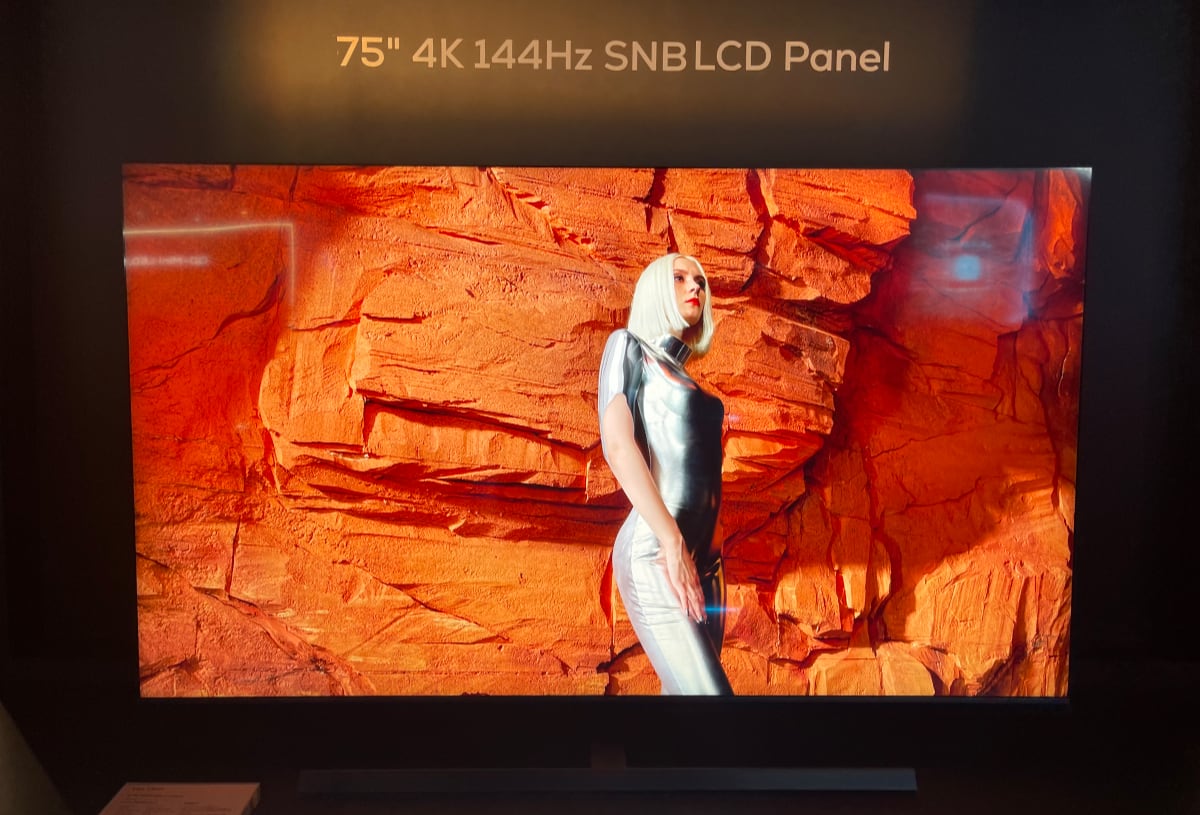
Despite OLED TVs, QD-OLED TVs, and now QDEL displays stealing all the limelight at CES 2024, LCD TVs aren’t seemingly dying out any time soon.
In fact, TCL might be rejuvenating the TV technology in a way that could prove to make them even more reliable than OLEDs — at least in terms of viewing angles and possibly even narrower bezels.
In the midst of wall-to-wall technological innovations at CES 2024, TCL CSOT, the company’s panel manufacturing arm, highlighted a breakthrough LCD panel upgrade it’s calling “WHVA.” It’s an updated iteration of its HVA panel technology, which refers to its own in-house developed PSVA (Polymer Stabilized Vertical Alignment) tech, allowing its LCD displays far more leeway in terms of the aforementioned viewing angles – the “W” in WHVA in this case standing for “Wide.”
Beyond demoing new LCD displays with wider viewing angles, CSOT debuted a new “SNB” (Super Narrow Bezel) design could make borders on LCD panels that much more “infinite.”
Here's why you want wider viewing angles

In June of last year, several reports claimed that LCD TV panels were essentially kaput in terms of outward development. These claims, however, proved to be a misunderstanding, as liquid crystal layers will still find ways to improve despite the ever-rising popularity of OLEDs and Mini-LED TVs.
And, it seems that’s true, at least in the case of TCL CSOT, a panel manufacturer that supplies several of the largest TV companies, including Samsung, Sony, and TCL, with their LCD panels. At CES 2024, the company had on display an 85-in 4K panel that sported an interesting new technology it is calling “WHVA.”
To understand this new innovation, we must first look at the firm’s VA (vertical alignment) LCD TV technology, which it refers to as “HVA.” As already mentioned, HVA is essentially the same LCD panel as seen on counterparts, except TCL CSOT makes it in-house and claims it sports improved contrast ratios over rivals.
Get instant access to breaking news, the hottest reviews, great deals and helpful tips.
Its new WHVA panel is intended to be the next step, amending the viewing angle issues that have plagued LCD screens for years on-end. Where the “H” in HVA stands for Huaxing, taken from the Chinese initials of CSOT, the “W'' in this case stands for wide, improving LCD TVs with better wide angle viewing (potentially) without sacrificing color and contrast.
It’s not like there aren’t already existing answers to the viewing angle issue on LCD TVs, though. IPS LCD screens, for one, allow such displays better viewing angles, but they come at the cost of middling contrast levels. These types of screens also require as much as 15% more power over standard LCD TVs, making them rather poor replacements, especially in terms of being environmentally friendly.
Sony’s X-Wide Angle screens come with much higher black levels, while Samsung’s sub-pixel dithering must reduce the TV’s resolution.
Sony and Samsung have also approached the issue with their own formulas, with the former leveraging so-called X-Wide Angle special layers on its LCD screens, and the latter using sub-pixel dithering, both of which come with their own downsides: Sony’s X-Wide Angle screens come with much higher black levels, while Samsung’s sub-pixel dithering must reduce the TV’s resolution.
There’s little in the way of additional information on TCL’s new panel technology, but those in attendance at CES could tell just how well-rounded the experience truly is. Given that it’s set on an LCD screen, it’s not going to look perfect, but it is an interesting new approach to the LCD problem. TCL CSOT does note, however, that consumers will have to wait until at least 2025 to experience this new breakthrough.
The narrower bezels, the better

On top of improving the viewing angles on its LCD panels, TCL CSOT also aims to make bezels on such TVs far slimmer. The company demonstrated at CES a new “SNB” (Super Narrow Bezel) innovation on a 75-in 4K LCD panel, which aims to give LCD TVs some parity with their OLED counterparts.
SNB LCD TVs will leverage borders at a 2.7mm size and a 7.7mm bottom size, resulting in a much more infinite-esque panel. While it’s nowhere near as nice as alternative options in the premium space, narrower bezels is certainly a plus and will allow users improved screen real estate and staging.
TCL CSOT announced in March 2023 an upgraded ultra-thin-bezel design for mobile devices, aiming for as much as a 30% reduction of bezels. While pertaining primarily to the mobile sector, it shows just how much the display group is innovating on its approach to screen development.
TCL might not be making any 8K TVs this year, but it's certainly pushing innovation forward. Much like its WHVA panels, availability and production timelines regarding the SNB LCD TVs remains unknown. It’s a safe bet not to expect any of these upgrades on LCD TVs until 2025 at the earliest, with several alternative TV manufacturers not far behind.
More From Tom's Guide
- TCL's mind-blowing QM89 Mini-LED TV is 115 inches and has a peak brightness of 5,000 nits
- TCL QM8 Mini-LED TV (2024) hands-on review: Brighter, bigger and better
- TCL Q7 QLED TV review

Ryan Epps is a Staff Writer under the TV/AV section at Tom's Guide focusing on TVs and projectors. When not researching PHOLEDs and writing about the next major innovation in the projector space, he's consuming random anime from the 90's, playing Dark Souls 3 again, or reading yet another Haruki Murakami novel.
